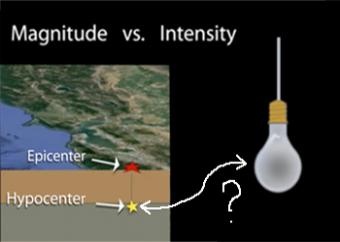
What's the difference between seismic hazard and seismic risk?
Hazards are anything that can cause harm. Risk is the potential for a hazard to cause harm.
A seismic hazard is the probability of ground shaking due to earthquakes, and other effects of earthquakes including ground rupture, landslides, tsunamis, and soil liquefaction.
Seismic risk is likelihood that humans might sustain injuries and fatalities, plus economic losses due to the hazard. Risk, and perception of risk are not always aligned.
CLOSED CAPTIONING: A .srt file is included with the download. Use an appropriate media player to utilize captioning.

Earthquake intensity (what is felt during an earthquake at any given location) is often mistaken for earthquake magnitude (the instrumentally measured size of that earthquake). This animation describes the main factors that contribute to differing intensities using examples of earthquakes. Produced in collaboration with the U.S. Geological Survey.

Magnitude and intensity are both related to the size of an earthquake, but they each measure different aspects. One is measured using seismometers; the others is felt. Let's use a lightbulb as an analogy.